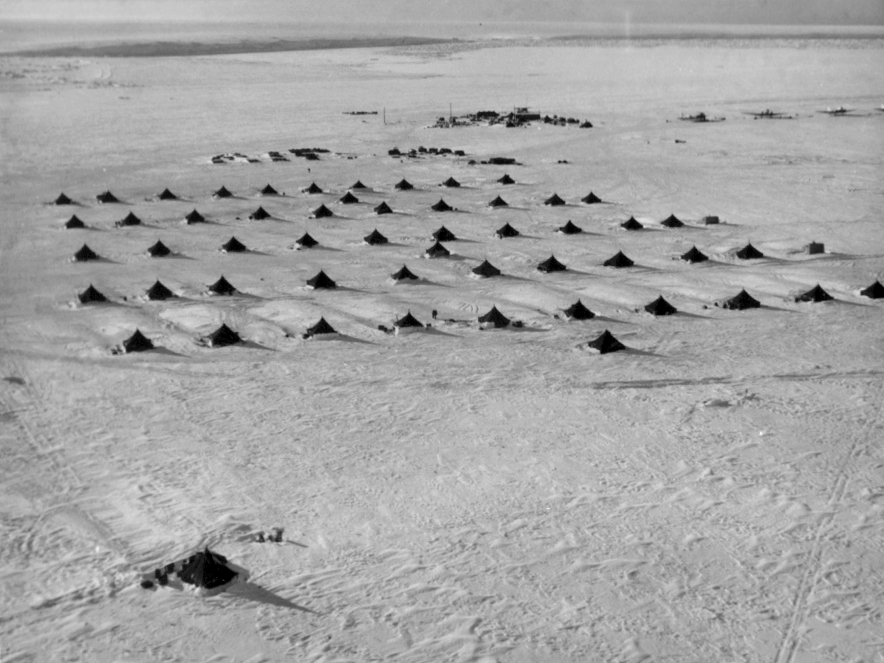Dear Sir,
The so-called “Expedition” by Rear Admiral Byrd was officially called “The United States Navy Antarctic Developments Program, 1946-47” and was code-named “Operation Highjump”. This operation is fairly well documented (just google it) and although there was a “hidden agenda”, the truth is quite unspectacular to say the least.
In order to understand what was going on we need to examine an old whaling practice, dating back to the 19th century. Whalers (or better said the companies who owned the vessels) used to stockpile food, equipment, material, etc. on deserted islands near the Antarctic (and the Arctic as well for that matter) in case they’d run into problems. During the first World War, the British Admiralty feared German U-boats would use these stocks to extend their patrols and decided to destroy most of them. The Germans, in returns, hadn’t planned on requisitioning these stocks (as they lacked various essential components for prolonged submarine warfare such as spare torpedoes) but considered building their own stocks/bases in Arctic and Antarctic regions. This never happened as they lost the War (defeat came swifter than they had anticipated).
Once the Schwabenland Expedition returned successful, Admiral Karl Dönitz, Commander of the German U-Boats, resurrected that old WW I plan to build secret bases in Arctic and Antarctic Regions (these included for example a weather station on Greenland). In 1936, it was decided that hostilities would begin in 1944 and by that time the U-boat support bases should have been ready. As the Second World War broke out five years earlier, the plan could not be fully implemented.
The Germans did manage to establish a base (Base 221, code-named “Neu Berlin”) but it was far from finished and could only support some 600 men for a limited period of time. Towards the end of WW II, some personnel was evacuated to this base and the occupants became known as “The Last Battalion”.
One of the aims of Operation Highjump was to check out this base. By 1946, figures had been exaggerated by both German POWs and US Naval Staff in Washington (Exaggerating enemy the enemy strength was common in those days in the military; it was considered to be a “safe” option). At the same time, Rear Admiral Byrd, hoping for one last famous expedition, did nothing to contradict these figures. The Office of Naval Intelligence (ONI) and the British Admiralty however seriously questioned the whole situation.
As it turned out, Base 221 had been abandoned, its personnel had fled, by submarine, to South America (usually trading their subs for permits to stay). Some of the crew were debriefed by ONI (some even before Operation Highjump began) and it turned out that “The Last Battalion” preferred the South American Sun over the Cold Antarctic; they had all simply “deserted”. Base 221 was nothing more then an empty tunnel dug into the ice. The British blew it up.
There were no Nuclear Weapons involved in Operation Highjump. First of all, the entire US Nuclear Stockpile counted exactly 4 bombs at that time (2 x Mk-I “Little Boy” and 2 x Mk-III “Fat Man”). Second, the only aircraft capable of Delivering Nuclear Weapons were converted B-29 Superfortresses (under the Silverplate Victor Prgoramme) and the British Lincoln B.I, both were too large to operate from an aircraft carrier.
Operation Highjump was cancelled early as all necessary data had been gathered and no Germans remained, besides, another six months would have meant spending the Winter there and nobody in his right frame of mind would actually want to do that, least of all Admiral Byrd who knew what he was talking about.
The comment of Admiral Byrd on “the possibility of the US being attacked from planes from beyond the poles” referred to the Soviet Tu-4 aircraft. Unknown to the public at that time (Atomic Weapons were very hush-hush), the Soviets had duplicated a B-29 Superfortress that had made an emergency landing in Vladivostok during WW II. Should the Soviets develop a Nuclear Weapon, they could drop it by Tu-4. As it turned out later, Soviet Tu-4 aircraft were not Nuclear-Capable but the first Soviet Bomb in 1949 did take the US by surprise (they thought it would have taken them at least another 6 to 11 years). That’s what behind Admiral Byrd’s cryptic message. In case of such an attack, interceptors, both Land-Basd and Carrier-Based, would have had to shoot down Soviet Bombers. These interceptors, being short-range aircraft, would have had to operate in Arctic conditions, that was one of the main aims of the whole expedition. Testing radar in extreme conditions was another one. On the other hand, High Temperature radar test were conducted in the dessert at White Sands for example, close to Roswell AAF (and again a lot of stories).
Some “quotes” from the so-called journals are often fakes and hoaxes and I shouldn’t pay too much attention to them. A lot of people seem determined to prove that Germany had a top secret abse in the Antarctic, including Flying Saucers. Such people usually happily ignore most relevant and easily accessible facts.
Wiki gives an OOB of Operation Highjump and the US Archives have more information. Just ask DoD or the National Archives.
Kind Regards,
Thierry Rotty.
